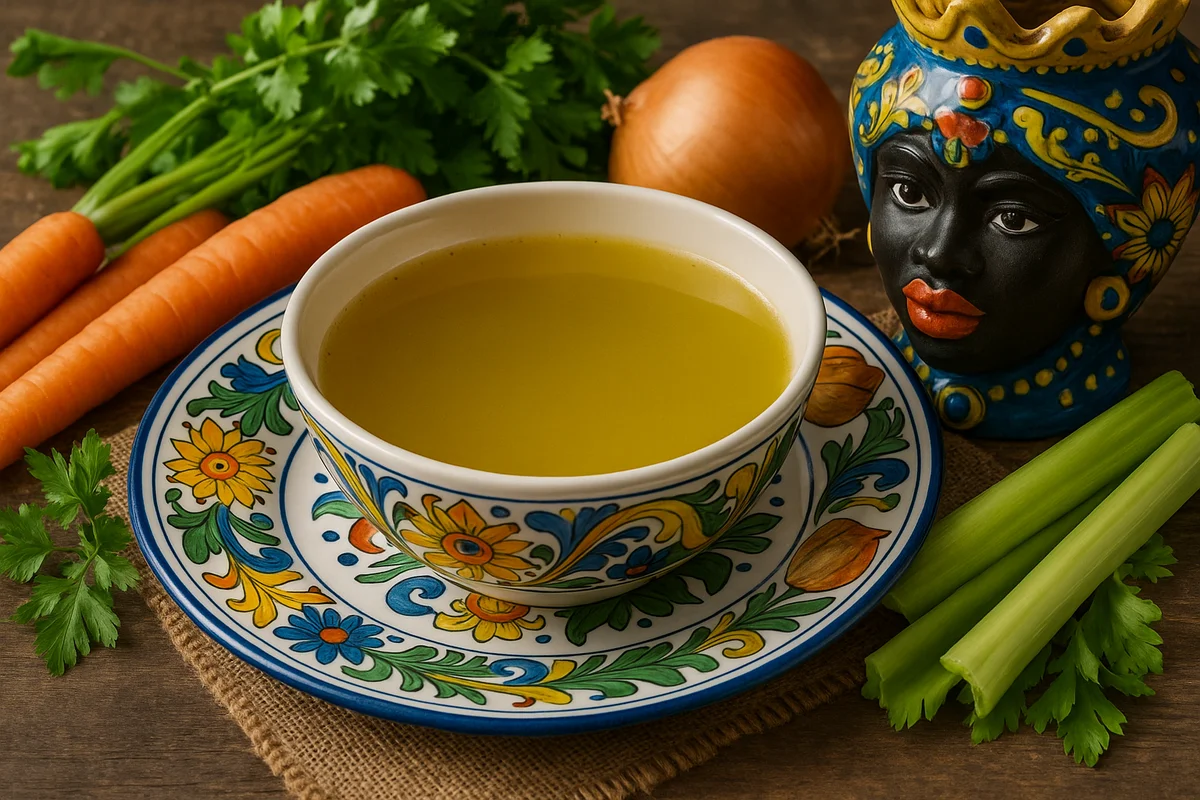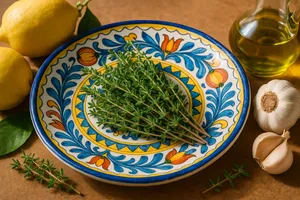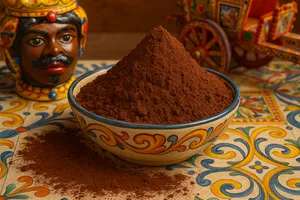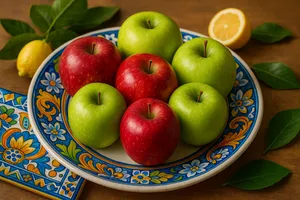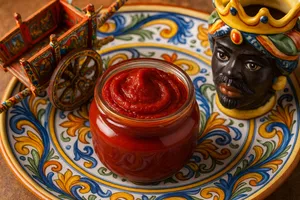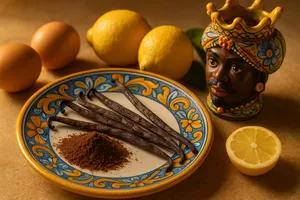Overview
Vegetable broth, known in Sicilian as “vrodu 'i virdura” or “broru di l’ortu”, is a fundamental preparation in traditional Sicilian cooking—a light yet flavourful base for soups, risottos and countless other recipes. This aromatic liquid, obtained by slowly simmering fresh vegetables and herbs, is the plant-based alternative to meat and fish broths and is appreciated for both its delicacy and versatility.
In Sicilian tradition, vegetable broth was prepared using whatever vegetables were available in the family garden, following the principles of rural cooking that valued seasonal, local produce. During Lent and on “lean days”, when meat consumption was restricted according to Catholic custom, vegetable broth became a staple, forming the foundation of soups and dishes meant to nourish without weighing the body down.
Characteristics
A well-made vegetable broth has a light golden colour, clear or slightly cloudy depending on the vegetables used. The aroma is delicate yet pronounced, with sweet notes from lightly caramelised vegetables and fresh scents from added herbs.
The flavour is balanced—naturally sweet from the vegetables, lightly savoury once salted, harmonious without any single ingredient dominating. Its texture is light, less rich than that of meat or fish broths, but pleasantly rounded and smooth on the palate.
Traditional ingredients
The classic Sicilian vegetable broth is built on four essential vegetables: carrot, celery, onion and tomato—the “four pillars” of the island’s broth-making tradition.
Other common additions include zucchini, potatoes (which add body), leeks (for a milder onion flavour) and green beans. Some variations include a leaf of cabbage or savoy for a richer result.
Essential herbs are parsley, fresh basil, bay leaf and sometimes a sprig of rosemary or thyme. Some traditional recipes call for a piece of pecorino rind to add savouriness and depth. Salt is always added at the end, for better control.
Traditional preparation
The preparation is simple but requires care. All vegetables are washed and cut into large pieces—small cuts would disintegrate during long simmering and cloud the broth.
Vegetables are placed in a large pot, covered generously with cold water and slowly brought to a simmer. Starting from cold water allows flavours to be gradually extracted. Herbs are tied into a bundle for easy removal.
Once the broth reaches a gentle boil, the heat is reduced to the lowest setting, letting it simmer for 1–2 hours. Some recipes call for up to 3 hours for a more concentrated flavour. Any foam rising to the surface is skimmed off, though vegetable broth produces little.
Salt is adjusted only at the end. The broth is strained through a fine sieve and the vegetables—having released their flavours—are discarded. The liquid can be used as-is or reduced further for a stronger taste.
Culinary uses
Soups and stews
Vegetable broth forms the base of vegetable soups and legume- or grain-based dishes. It is ideal for cooking pasta, rice or farro, resulting in light but nourishing meals, especially appreciated during Lent.
Risottos
A good vegetarian risotto depends on a quality vegetable broth added gradually during cooking. It provides creaminess and flavour without overpowering the main ingredients.
Cooking grains and legumes
Used instead of water, vegetable broth enhances the flavour of rice, barley, farro and legumes. It’s especially recommended for pilaf and creamy barley dishes.
Sauces and condiments
It enriches vegetable sauces, adds body, helps thin out concentrated tomato preserves and moistens preparations that would otherwise be too dry.
Braised vegetables
Vegetables such as artichokes, fennel or cabbage are gently braised in broth, becoming tender and flavourful.
Regional variations
Sicily offers many variations depending on area and season. In the eastern part of the island, wild fennel is often added for its distinctive aroma. In the west, ripe tomatoes are favoured for their colour and sweetness.
In mountain regions, wild or foraged greens such as cardoons and field beets are used, giving the broth a rustic, intense character. In winter, cavolo nero or savoy cabbage add body and heartiness.
A traditional “poor kitchen” variant uses vegetable peels (well washed) to create a flavourful broth based on the principle of zero waste.
Storage
Vegetable broth keeps in the refrigerator for 4–5 days, slightly longer than meat-based broths, stored in well-covered glass or food-grade plastic containers. It should be cooled quickly after cooking, for example by placing the pot in cold water.
For long-term storage, it can be frozen in portions. It freezes well for 4–6 months. Freezing in ice cube trays is particularly useful for adding small amounts to risottos, sauces or sautés.
Before using stored broth, bring it briefly to a boil. Being vegetable-based, it carries fewer microbiological risks than broths made from animal products.
Nutritional properties
Vegetable broth is very light—around 10–15 calories per 100 ml—making it ideal for low-calorie diets. While low in protein, it contains minerals such as potassium, magnesium, calcium and phosphorus released during cooking.
It also holds water-soluble vitamins, especially vitamin C (if cooked briefly) and B vitamins. Antioxidants from the vegetables accumulate in the broth, providing additional benefits.
It is easy to digest, free of saturated fats and cholesterol, suitable for vegetarian and vegan diets, children, the elderly and people with digestive issues. In Sicilian folk wisdom, it was considered cleansing and refreshing.
Tips for perfect broth
Use the freshest seasonal vegetables possible. Variety matters: the more types of vegetables, the more complex the flavour. Ideal proportions are about 1.5 kg of vegetables per 2 litres of water.
Do not over-peel vegetables—many nutrients and flavours are near the skin. Keep the simmer very gentle; a strong boil clouds the broth and dulls its flavour.
Avoid too many potatoes, which make the broth cloudy due to starch. For more body, use zucchini or carrots instead. Herbs should be balanced—not overpowering.
Common mistakes
Using old or poor-quality vegetables is the most common error: the broth highlights every flaw. Cutting them too small causes disintegration and cloudiness.
Adding salt early leads to over-salting as the liquid evaporates. Always salt at the end.
Too short a cooking time results in weak broth; too long results in bitterness, especially with cabbage or savoy. Avoid vegetables like eggplants or peppers, which dominate the flavour.
Curiosities
In Sicilian tradition, broth day was often Wednesday or Friday—lean days in the Catholic calendar. The aroma wafting through homes marked the rhythm of religious customs.
An old Sicilian saying goes: “‘U vrodu di l’ortu è medicina di natura” (“Garden broth is nature’s medicine”), highlighting its perceived health benefits.
Farm families often saved clean vegetable peels to make “recovery broth”, used to cook pasta or rice for animals or even to water the garden, returning nutrients to the soil.
During Holy Week, vegetable broth formed the base of nearly all meals, and women prided themselves on crafting the most fragrant broth using the best garden produce and family secrets.
In Sicilian folk medicine, specific vegetables were used with intent: artichoke broth for the liver, fennel broth for digestion, celery broth for calming effects—consumed warm in small sips as natural remedies.

